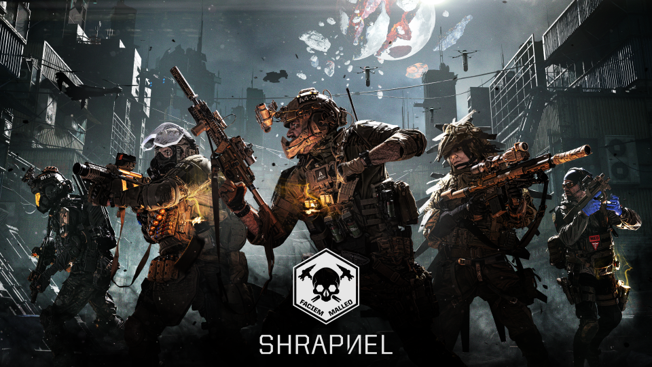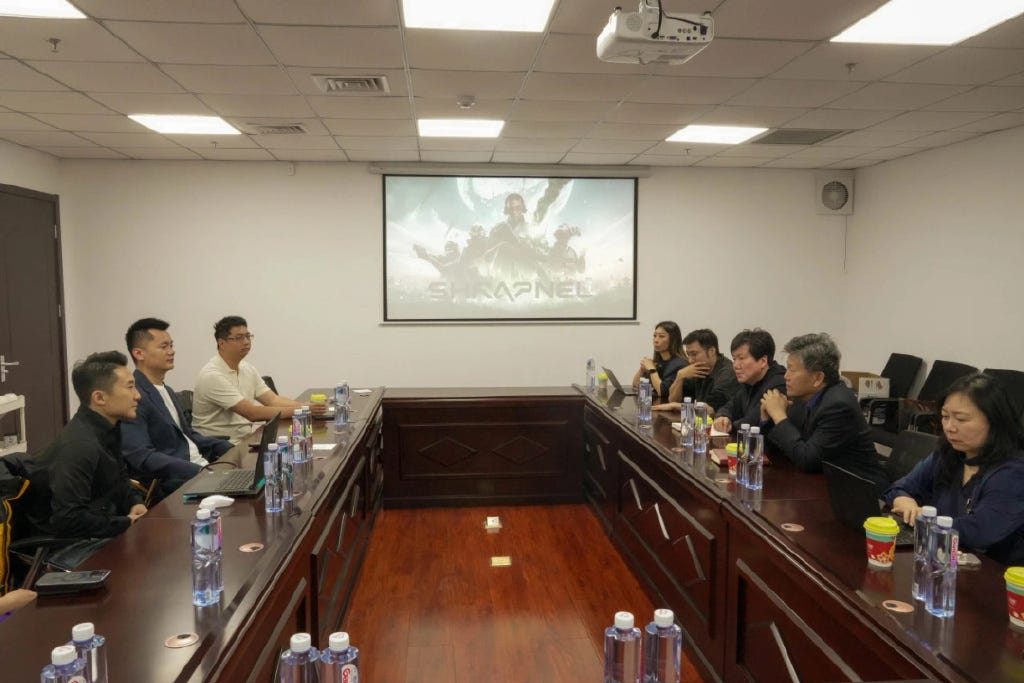SHRAPNEL Gameplay & Lore #2: Every Match a Story
What to expect from SHRAPNEL gameplay, and how players will carve their own narratives.
What SHRAPNEL means to you won’t be the same as anyone else.
A high-stakes extraction FPS, SHRAPNEL is a game that will ask how much you’re willing to risk with each and every dive into the Zone. Playstyles, loadouts, match length — everything is malleable.
To coalesce those concepts into what an average SHRAPNEL session will look like, we grilled Creative Director Clint Bundrick on gameplay, shooting mechanics, and how brains will always beat bullets.
SHRAPNEL is an FPS first and foremost, so how are you approaching gunplay and movement?
CB: So this is really top of our list. Players have grown very, very good at picking up a game for five minutes and passing judgment: is this quality or not? They know the difference. So for me, this is a big part of how we’ve hired our design team and how we’ve thought about things. Gun-feel, the feel of locomotion, and how you interact with the environment is really the first thing that we’re focused on. It is our top priority.
We also know that we want a pretty high ‘skill ceiling.’ We want players to feel like they can always get better, that there’s always a new gun, a new strategy, a new piece of tech to master. We also know that we want a full ballistics model. We want that sense of brutal and intense — I think of it as intimate — gameplay.
The other element of it is brains before bullets, or a ‘smart shooter.’ We’re making a game where the stakes are high. You’re competing over things that have real-world value. It’s single-life, no-respawn gameplay, so it’s high stress too. All of that makes me want to create a scenario where players think first and shoot second.
They might not engage every time they see somebody else because there’s a persistent health model. They know if they take damage now, it’s going to weaken them later in the game. They’re thinking about their resources. They’re thinking about giving away their position. These are all things we want the player to consider, not just who they’re fighting and what gear they have.
What are they trying to get out of the session? What are their chances of winning that fight? What are the consequences of winning it? Yeah, you won, but you ended up damaged and weakened for the rest of the session.
So at its heart, it is a tactical shooter built on a full ballistics model. But I also want to find all kinds of ways to make players feel like their choices, their tactical choices, are really what determine the outcome of their encounters. I’m fascinated to see what kind of gameplay styles come out of it.

So how will SHRAPNEL encourage different approaches to just hunting kills every game?
CB: One of the things we’re talking about is how we support different motivations for players. Say I’m joining a game and I just want to gather some resources and then get out early. I’m going to scavenge, and I’m going to build my entire playstyle around that. I might bring a cloaking device that has a hyper-limited use. I’m going to focus more on mobility, and I’m going to nibble around the edges. I’m going to be an opportunistic hunter, if I hunt at all. Otherwise, I’m going to scavenge the bodies, try to get a little bit of the early game Sigma, and then get out on one of the early dropships.
Or maybe I’m gonna go to the end game — all the way to ‘act three’ of a session. I am going to come in armed to the teeth, and I’m going to bring in abilities that I know will make me powerful, because I know I’m going to be going against the highest-level players. I’m going to be hunting the most dangerous wolves, because I want to be there at the end when the most valuable loot shows up. I’m going to be on that last dropship or die trying.
And when these different player motivations are in the same play session? We’ll see some really interesting texture — how players interact with that kind of cross motivation.
You can have a world in which uneasy alliances can emerge. Where you and I encounter each other early, and we’re just pointing our guns at one another but slowly backing up because neither of us wants to get hurt. Shooting early might not match what we’re actually here to do.
I love the idea of those uneasy alliances where you and I both put our hands up and then we kind of work together. But when that last Sigma drops, or some high level player comes into our crosshairs and it’s time to take their stuff, they’ve only got one of those guns. Is one of us gonna let the other just take it peacefully? Or does our alliance crumble in the end, when one of us tries to grab the bag of goodies and get out?

When discussing SHRAPNEL’s world, you mentioned mystery and the unknown being at the heart of the experience. How will that translate to gameplay?
CB: One of the things that we talk about with the game is that every session is its own story. That’s one of our mantras. When we think about the game, when we think about our systems, mechanics, storytelling, or framing, it’s all about making it feel like every session is its own story.
So that means players don’t know what they’re going to find when they’re in the world. They don’t know exactly where the dropships are coming in. They don’t know who they’re going to encounter along the way. Dynamic elements like meteor showers happening in the middle of a gunfight. All these things can make it so that every session feels unpredictable.
That meteor shower might completely change the outcome of an encounter. You might have a really difficult fight early, and now you have this persistent injury. Did you bring enough health items in order to patch up your legs, or are you going to get out on one of the early dropships? Balancing all of that is going to be one of our more interesting challenges.
At its core, we want the game to feel grounded, right? This is not Apex, this is certainly not Fortnite. We want this to be a heavy, grounded experience. But we want to make sure that we have enough flexibility there to have some real magic in terms of future tech that changes the way players think about the environment, how they think about their role on their team.
How long do you see a match of SHRAPNEL lasting? Can you give us a sense of scale for each game or map?
CB: I want to make sure that players always have a choice. If a player has just 15 minutes to get in a round of SHRAPNEL, we want to make sure that we can do that. If somebody wants a much longer, more in-depth experience — they want to feel the drama, the stakes, the tension — then yeah, they should be able to come in and play a 45-minute, 60-minute session.
Our tiered dropship system gives the player a lot of that agency. So even in a map that’s large enough to support 40 people, and it’s a 45-minutes-long session, they can get out 15 minutes early. But also, I think players will want the option of smaller maps. We’ll want to give the community lots of flexibility, not only in how they play, but also what they create.
We might have somebody from the community that builds an incredible map that’s perfect for eight people — probably a 10-to-15-minute match. And if the community is like, “yes, we love this,” then great, we support that.
I love the idea of being able to support the longer sessions as well. What that upper bound is will probably be partially defined by what the community makes. My initial stake in the ground is about 45 minutes. We’re going to be seasoning that to taste as we go, but I do want lots of variety in there. It’s going to be part of not only our team building maps, but also working with the community to build their own.

Want to learn more about SHRAPNEL’s universe? Read our world and story Q&A here!
Join our Discord now for your chance to influence the development of the game and win prizes along the way.

